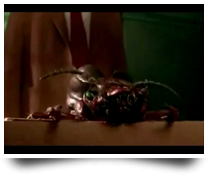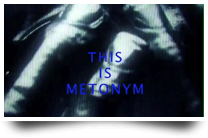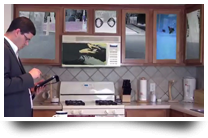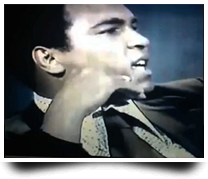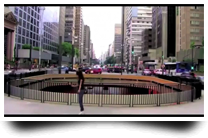

Anomalous Composition
A Horror in Video
Robert Leston
screencube
bonnie lenore kyburz
Metonymy
Virginia Kuhn
Walking in the (Electra)City
A Fevered and Frivolous Spectacle
Justin Hodgson
Vorhandenheit
Jason Helms
A Thrilla in ManiLA
Geoffrey V. Carter
The Dancing Floor
Sarah J. Arroyo and Bahareh Alaei

The work presented here was originally produced for and shown on January 6th, 2012, at the Modern Language Association Conference in Seattle, Washington. The panel was arranged by the Committee for the Teaching of Writing and was curated by Victor J. Vitanza.
This panel-turned-webtext follows on the Panel to Gallery session that Victor curated at the 2006 Conference on College Composition and Communication Convention (Arroyo et al). Those presentations, revised as From Gallery to Webtext, can be found online in the Kairos 12.3 Manifesto Issue. Watching these earlier webtexts first will give readers a sense of the then and now. No one is suggesting linear progress or increased sophistication. Rather, we (Victor Vitanza and Virginia Kuhn) are suggesting that you be on the lookout for video/s that simultaneously imp/lode and exp/lode. Rhythmically.
The purpose of the the 2012 Gallery setting was, once again, to show and demonstrate how digital technologies are reshaping our views of conferences, of presentations, and in a wider scope of writings.This Panel to Gallery session set aside the traditional diachronic set of presentations for a synchronic set, in an art e-gallery format, with each writing arranged separately as conceptual art installations. There were eight different tables, widely separated with four tables on each side of the large room, comparable to MoMA's "MediaLounge."
As visitors walked into the Gallery (hotel ballroom), each was handed a one-page press release. Once visitors had a sense of the possibilities, each mixed as if at a gallery opening, speaking of the works with the artists and among themselves. The most asked question, of course, was What does all this work have to do with the teaching of writing? Each presenter, when asked, invited the questioner to reconsider what the word writing might variously mean today. The conversations were lively.
So as to continue with that purpose in mind—making writing e-lively—the seven artists have revised-reworked-replayed their presentations for Kairos on the Web. Some have even changed their titles, while others have re-envisioned their whole presentation.
Virginia Kuhn (VK): Hey! Hey! What about our talking quickly through these objects/projects, projections/objections!
Victor Vitanza (VV): Okay, VK, let's attempt a sparse dialogue on each of the videos. How they ex-plode. Or vice versa. Whatevver!
VK: Okay, VV, first, let's accept that a W is a W, not two Vs scrunched, VV, together! So stop that nonsense. Enough is enough!
VV: VVhateVer you vvish, VK. But have you looked at our alpha bet names? You are a V with a K, but that's really a re(in)formed couple of Vs issuing forth a pinched third V.
VK: You are incorrigible, intractable, etc.
VV: Okay, since we have talked about me and you, let's turn to some basic issues and questions about this second effort of rethinking the conditions for the possibilities for writings.
VK: Okay, so since you reversed the alphabet, we will begin with Robert Leston's "Anomalous Composition". A perfect performance of a perverse reversal. The question that viewers will most likely ask is Does this first video set the theme for the other seven videos?
VV: I have no interest in that kind of relationship. No linear development. But a zig-zag at best. To where? I cannot say. . . . Let us keep in mind that Leston is working with Deleuze and Guattari's para-critique of traditional hermeneutics: "You said X, but what you really mean is Y"! We are saying, however, You say Y, but what you really mean is X!
VK: And therefore he is following D&G's refusal of such a hermeneutic and, in doing so, embraces becoming-animal, becoming-imperceptible.
VV: Therefore, yes, by happenstance, we are following Leston. One way or the other vvay! All that follows will be as contrary as his and ours thus far have become. Or so it seems at first! . . . Your thoughts?
VK: I'm wondering if the X and Y, Y and X, has something to do with genetics and sexuality? I'm thinking gene splicing. XX and XY are the norms. How about YY? WhyVVhy? But that's besides the point. Let's move on. . . . With bonnie lenore kyburz's "screencube." bonnie tells us, "This installation is a contemplation on a process of desire. . . . I had been wanting to create private pleasure in a public space."
VV: Uh oh! . . .
VK: bonnie's installation is all so powerful. She invites the viewers to reinstall themselves in this in-out-stallation. . . while in the box, out of the box. While in stasis, ex-stasis. . . . What haunts me in this first of three videos is that I am in a box that is becoming a xob. As in Leston's work/play, being is becoming.
VV: The third of the three videos by blk—with bonnie in dialogue with Cheryl Ball—really gets to the outside of the video in the box, with both bonnie and Cheryl recalling a viewer who needed to intervene and fix the video projection onto the back wall of the box/skubb, away from the side walls that were taking the images to the outside, i.e., that were making the images flow toward the outside. Of the box/skubb. That's desire, flowing wherever there is a sublime object of ideology. That haunts.
VK: next is me.
VV: yes, you, you, and you, Virginia Kuhn. Let's look at the word-with-words. Metonym, "Metonymy," part-part (as opposed to, but often historically confused with, synecdoche, part-whole, or as you say "w/hole"). The con-fusion can be destructive-productive. So yes, again, vice versa. The production is, as you characterize it, "a continuous metonymic stream that turns representation on its eye, bearing no indexical relationship to the world. In this environment, narrative breaks down, sovereignty is in unrelenting flux." Often metonymy has been thought of as controlled by a part-part relationship such as cause and effect, until another trope by the name of metalepsis stepped in, reversing cause for effect, effect for cause. That's desire, flowing. (Cf. antonym.) In search of the lost object. Let's get dizzzzzzy!
VK: What have you un-just done to my video that is not a video! But that's oKay; the last shouted line (THIS IS METONYMY) becomes the false positive anyway...
VV: Moving onvvard to. . . .
VK: Justin Hodgson's "Walking in the Electra(City", is a frenetic breakdown and breakout to Charles Baudelaire (1955) and Walter Benjamin's (2002) notion of the flâneur strolling through the city. Virtually, it's more so Michel de Certeau (2002) and Paul Virilio's (1994) notion of the post-flâneur flying through the city. Justin offers us, as he claims, "a metonym for electrate-culture." Justin walks us—rather, throws us—through the (electra)city. We become connected, yet disconnected. Our bodies can but vibrate vibrate vibrate. We become, as Justin says, "fevered and frenzied tropes." We are but objects of the spectacle! The situation? That's desire, flowing. We become ob-jects in search of more ob-jects. Frenetically. . .
VV: Oh, let's slow down. To a crawl. Let's move the mouse slowly across the screen. Jason Helms invites us to do just this: crawling and scratching across the screen until we start screaming! In search of the hidden link. Which he refers to as "a hidden button game." . . .
VK: Why don't you start with the title! "Vorhandenheit!"
VV: Well, the slide (sly) show starts easily enough. You just click on "Next," but thereafter, you will find yourself in an impossible search for the button. Contrary to all the videos we have experienced previously, this slide show (not a video) makes us slowwwwww dovvn. Invites us to peal away the layers in search of the ground (Grund). In our search, the slide show can make us upset. Make us beside ourselves. As we peal away we read, "On to Heidegger then." Try it. Cry it. While you are prying and prying your way to the Grund. Regressively so/w. Only to uncover your frenetic scratchings, your hammering, your event.ual pain in uncovering yourself in the pane of your reflextions. In the window. . . . Enough said. Go try it to discover how trying it can become. Revealing!
And Geof Carter's piece, "A Thrilla in ManiLA," might help us through this stage of mourning for our old selves and lost wor/lds. And yet, it, too, is all about a lost object. Namely, recognition. Being remembered. The questions: Who deserves a statue? Stasis? In history? In Philadelphia. The specific question that Geof interrogates is the figure (a phantom) of Rocky (Ali through Stallone, or Stallone through Ali, eclipsing Frazier and Wepner). After all is said and undone, it's SHOVVBUSINESS!
VK: Arggggggg.
VK and VV: The knock out, wake up, here may very well be Sarah Arroyo and Bahareh Alaei's "The Dancing Floor"! Which exemplifes the very dance of maintaining stasis. And yet, thereafter, by wayves of working/playing on YouTube as Chora. As Jay David Bolter (1991) said: "The task will be to build, in place of a single argument, a structure of possibilities" (p. 119).
VV and VK: It's Showbusiness! That's all folks!
References
Arroyo, Sarah; Carter, Geof; Edbauer, Jenny; Hawk, Byron; Haynes, Cynthia; Kuhn, Virginia; Kyburz, Bonnie Lenore; Leston, Robert; Rice, Jeff; Richardson, Timothy; Sosnoski, Jim; & Vitanza, Victor. (2006, March 25). From panel to gallery. Presentation at the Conference on College Composition and Communication, Chicago, IL.
Baudelaire, Charles. (1955). À une passante. In Marthiel Mathews & Jackson Mathews (Eds.) Les Fleurs du Mal. New York: New Directions.
Benjamin, Walter. (2002). The arcades project. (Howard Eiland & Kevin McLaughlin, Trans.). Cambridge, MA: Belknap Press of Harvard University Press.
Bolter, Jay David. (1991). Writing space: The computer, hypertext, and the history of writing. Hillsdale, NJ: Erlbaum.
Certeau, de, Michel. (2002). The Practice of Everyday Life. Los Angeles: University of California Press.
Virilio, Paul. (1994). The vision machine. Bloomington, IN: Indiana University Press.
Acknowledgements
Anthology Editors: Victor Vitanza, Clemson University, and Virginia Kuhn, Institute for Multimedia Literacy (IML), University of Southern California
Interface Concept + Design: Virginia Kuhn, IML, University of Southern California
Interface Design + Architecture: David Lopez, IML, University of Southern California
Special thanks to Jon Morehouse (IML Lab Tech) for HTML5 help.
